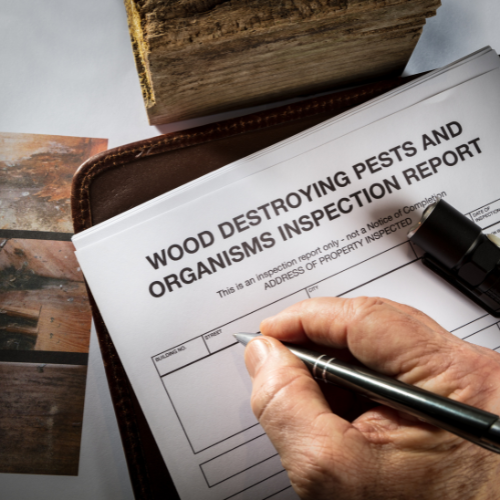
09 Jan Warning Signs of Termite Infestation
Termite Risk Factors
Hello to all homeowners, renters, and landlords! Have you considered the possibility of termites in your home? These small, destructive critters often go unnoticed, wreaking havoc in your home’s structure. As experienced pest control experts, we have seen significant damage caused by termites and emphasize the importance of proactive measures.
Termites, a major threat to property, come in various types with unique behaviors. For example, Subterranean termites prefer underground living and can infiltrate homes undetected, while Drywood termites reside directly in wood. Identifying the type of termite is crucial for effective treatment.
Homes primarily made of wood, particularly those with wood-soil contact, are at higher risk. Homes in humid climates or with unresolved moisture issues also attract termites. Both new and old structures are vulnerable, making vigilance crucial for all properties.
Indicators of Termite Presence
Mud Tubes on Exterior Walls
Mud tubes, about the width of a pencil on exterior walls, indicate Subterranean termites. These termites build these tubes to travel from their underground colonies to their food sources in your home.
Regularly inspect your home’s foundation and crawl spaces for these tubes. They are more visible near the foundation and can also be found around pipes and other ground-connecting structures.
Damaged or Hollow-Sounding Wood
Termites eat wood from the inside out, leaving a thin layer of wood or paint. This damage often remains unnoticed until significant structural harm occurs.
Use a screwdriver or similar tool to tap along walls, baseboards, windowsills, and any wooden structures. Pay special attention to areas where wood contacts soil or where moisture is present.
Visible Termite Swarms or Discarded Wings
Termite swarms, often mistaken for flying ants, indicate a mature colony. Discarded wings near windows or doors are a common sign of infestation.
Regularly check for signs of swarms, especially after rain or in the evening. Discarded wings around your property should prompt an immediate professional inspection.
Unusual Patterns in Wood Structures
Maze-like tunnels in wood, known as galleries, signify termite activity.
Inspect less-trafficked areas like basements, attics, crawl spaces, and behind walls for these galleries.
Consequences of Ignoring Termites
Overlooking termite signs can lead to severe structural damage, with repair costs running into thousands of dollars. Termite damage can significantly decrease your home’s market value and is often not covered by home insurance.
Regular home maintenance is key to termite prevention. Ensure proper drainage away from your home’s foundation and fix leaks promptly. Regularly inspect your property for termite signs, especially in termite-prone areas. Professional inspections, ideally conducted annually, can identify infestations early.
If you suspect termites, act fast. Professional pest control services can assess the situation and recommend the best course of action.
Tailored Treatment and Monitoring
Ensure proper drainage to keep moisture away from your foundation, a key attraction point for termites. Fix leaks and damp areas promptly. Regular inspections are crucial, as professional experts can detect signs that might be missed.
A professional pest control service can provide a thorough assessment and recommend tailored treatment plans, such as environmentally friendly baiting systems, chemical barriers, or other methods. Continual vigilance is essential in keeping your home safe from termites. Regularly schedule inspections and watch for termite activity signs, especially after treatments.
Termites pose a significant threat, but with the right strategies, early detection, and professional assistance, you can protect your property. Regular maintenance, vigilance, and professional support are key to effective termite control, ensuring the longevity and safety of your home. Remember, investing in prevention and early intervention is always more cost-effective than repairing and recovering from termite damage.


No Comments